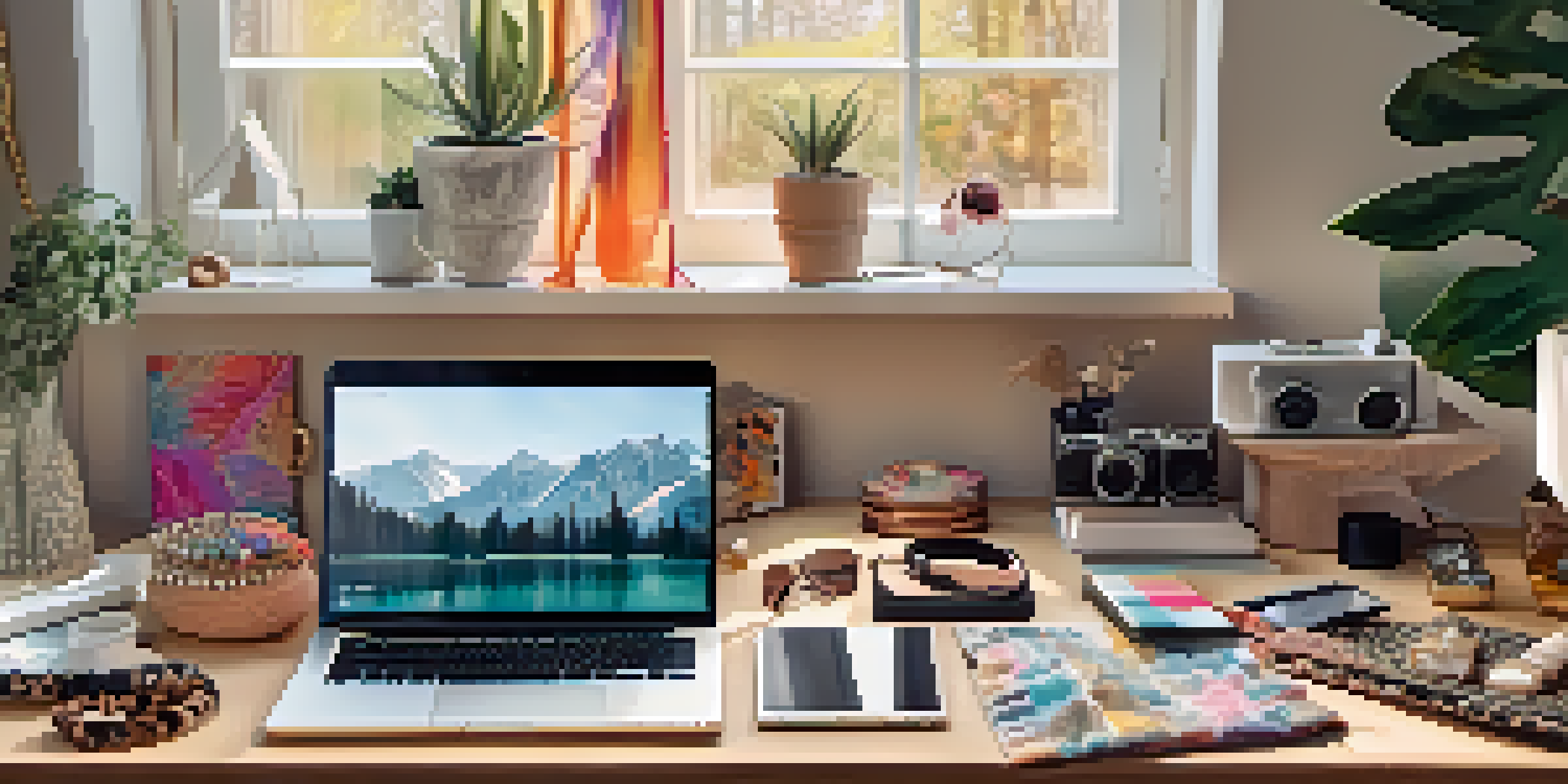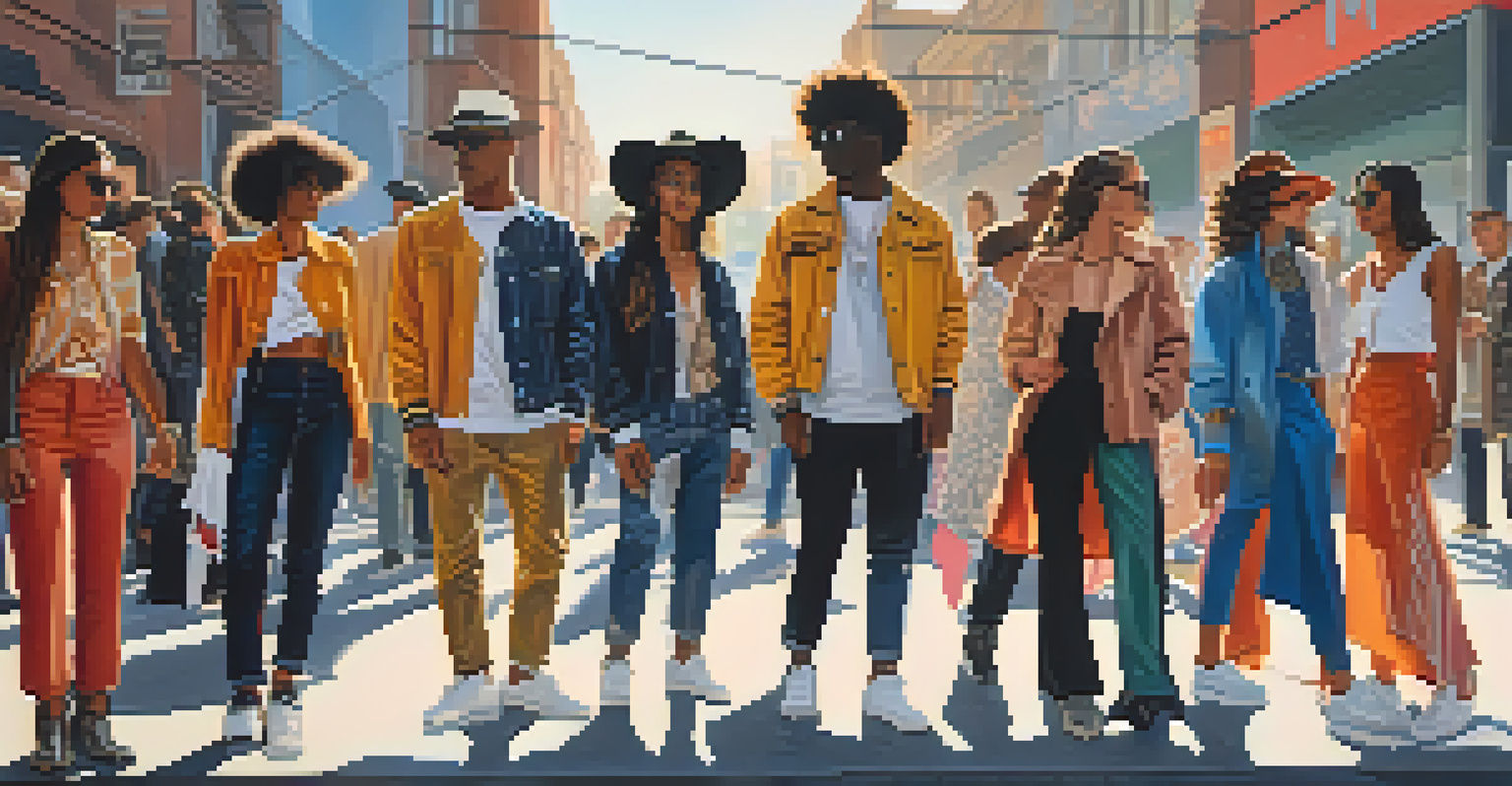The Power of Social Media in Connecting Fashion Enthusiasts

Social Media: A Game Changer for Fashion Lovers
In today's digital age, social media platforms like Instagram and TikTok have revolutionized how fashion enthusiasts connect. Gone are the days when fashion inspiration was limited to glossy magazines; now, a world of styles and trends is just a click away. This shift has made fashion more accessible and inclusive, allowing anyone with a passion for style to share their unique perspective.
Fashion is about something that comes from within you.
Fashion influencers play a vital role in this dynamic landscape. With millions of followers, they not only showcase the latest trends but also cultivate communities around specific styles and aesthetics. Their ability to connect with followers creates a sense of belonging, making fashion a shared experience rather than an isolated pursuit.
Moreover, social media encourages interaction among users, sparking conversations and collaborations that transcend geographical boundaries. This interconnectedness fosters a vibrant culture where fashion lovers can exchange ideas, tips, and inspiration, creating a global tapestry of style.
Building Fashion Communities Online
Online communities centered around fashion have flourished on social media platforms. Groups and hashtags dedicated to specific styles, sustainable fashion, and even vintage finds allow users to connect over shared interests. These communities provide a safe space for individuals to express their creativity and seek advice from like-minded individuals.

For example, platforms like Pinterest are treasure troves of inspiration, where users can create mood boards and share their favorite looks. This collaborative environment not only nurtures creativity but also empowers users to experiment with their fashion choices. Members often encourage each other, leading to authentic connections that go beyond mere likes and comments.
Social Media Empowers Fashion Lovers
Platforms like Instagram and TikTok have transformed fashion into a more accessible and inclusive space for enthusiasts to share their styles.
Additionally, social media events such as virtual fashion shows and live styling sessions have become increasingly popular. These events not only showcase talent but also foster community engagement, allowing participants to interact in real-time. This sense of camaraderie enhances the overall fashion experience, making it more enjoyable and immersive.
The Role of Influencers in Fashion Trends
Fashion influencers have become the new trendsetters, shaping what’s in vogue through their curated content. Their authenticity and relatability often resonate more with audiences than traditional advertising, making them influential tastemakers. When an influencer showcases a particular outfit or brand, their followers are likely to take notice and adopt similar styles.
Fashion is the armor to survive the reality of everyday life.
This phenomenon highlights the power of social proof; seeing a trusted figure wearing a certain look can validate a fashion choice for many. As a result, influencers not only inspire their followers but also drive sales and brand awareness. Fashion brands have recognized this impact and are increasingly collaborating with influencers to reach their target audience effectively.
Moreover, influencers often champion diversity and body positivity, creating a more inclusive fashion narrative. By showcasing a range of sizes, styles, and backgrounds, they help to reshape societal beauty standards, encouraging their followers to embrace their unique identities. This shift is not just about fashion; it's about fostering confidence and self-expression.
Social Media as a Platform for Emerging Designers
Social media has democratized the fashion industry, providing a platform for emerging designers to showcase their work. With minimal investment, up-and-coming creatives can reach a global audience, bypassing traditional gatekeepers like fashion buyers and magazines. This accessibility allows for a diverse array of voices and styles to emerge, enriching the fashion landscape.
For instance, platforms like Instagram have given rise to brands that might not have gained traction through conventional marketing channels. Designers can share their collections, receive immediate feedback, and connect directly with customers. This level of interaction not only fosters brand loyalty but also allows designers to adapt quickly to consumer preferences.
Influencers Shape Fashion Trends
Fashion influencers drive trends and brand awareness through relatable content, fostering a sense of community and encouraging diverse representation.
Furthermore, social media facilitates collaboration among designers, influencers, and consumers. Through partnerships and crowdsourcing initiatives, emerging brands can leverage the power of community to grow and thrive. This collaborative spirit nurtures innovation and creativity, pushing the boundaries of what fashion can be.
The Impact of Trends on Fast Fashion
The rapid pace of social media has accelerated the trend cycle, giving rise to fast fashion brands that can quickly produce and distribute styles. This immediacy allows consumers to keep up with the latest looks shared by influencers and peers. However, it also raises questions about sustainability and ethical practices within the fashion industry.
As trends come and go at lightning speed, consumers are often encouraged to make impulsive purchases, leading to a culture of disposability. This has prompted a growing backlash against fast fashion, with many advocates calling for more sustainable practices. Social media plays a pivotal role in this discourse, raising awareness about the environmental impact of overconsumption.
Consequently, many fashion enthusiasts are now seeking out sustainable alternatives and supporting brands that prioritize ethical production. This shift highlights a growing consciousness among consumers, who are using social media not just to share trends, but to advocate for change within the industry.
Creating Authentic Connections Through Fashion
Authenticity is a cornerstone of social media interactions among fashion enthusiasts. Users are increasingly valuing genuine content over polished, curated images. This shift has led to a rise in 'real' fashion moments, where individuals share their personal style journeys, struggles, and successes, fostering deeper connections.
By sharing behind-the-scenes glimpses and personal stories, fashion enthusiasts create a sense of intimacy and relatability. This authenticity resonates with others, encouraging them to join in the conversation and share their own experiences. It’s this vulnerability that often transforms casual followers into a loyal community.
Emerging Designers Find New Platforms
Social media democratizes fashion, allowing emerging designers to showcase their work globally and engage directly with consumers.
Ultimately, social media serves as a platform for storytelling, allowing fashion lovers to express their identities and connect on a personal level. These authentic connections enrich the fashion experience, making it more meaningful and impactful for all involved.
The Future of Fashion in a Digital World
As technology continues to evolve, the future of fashion on social media is bright and full of possibilities. Augmented reality (AR) and virtual reality (VR) are set to enhance the shopping experience, allowing consumers to virtually try on clothes before purchasing. This innovation could revolutionize online shopping, making it more interactive and personalized.
Additionally, the rise of artificial intelligence (AI) in fashion is reshaping how brands interact with consumers. AI-driven algorithms can analyze trends and consumer preferences, enabling brands to tailor their offerings more effectively. This adaptability will likely lead to a more satisfying shopping experience for customers, as they discover products that genuinely resonate with their tastes.

Moreover, as social media continues to play an integral role in the fashion landscape, we can expect to see even more diverse voices and perspectives emerging. The democratization of fashion is here to stay, empowering individuals to express themselves and connect with others in ways that were once unimaginable. The future of fashion is not just about clothes; it's about community, creativity, and self-expression.